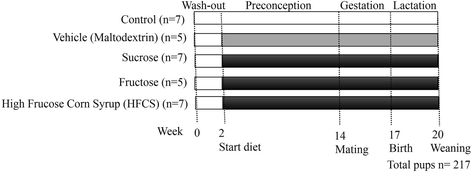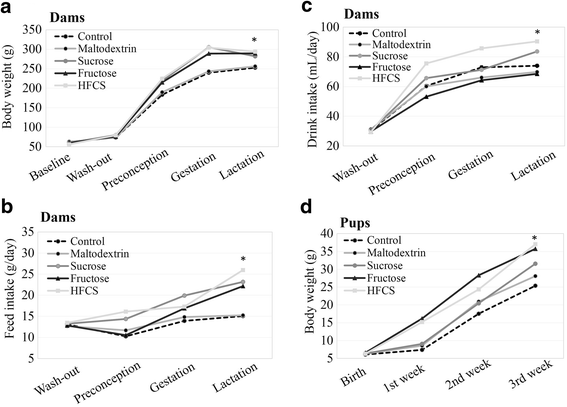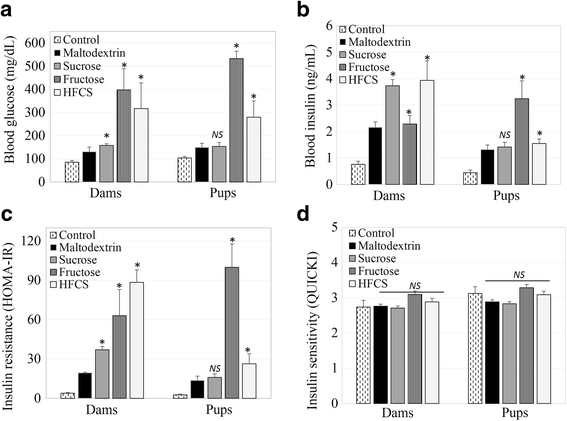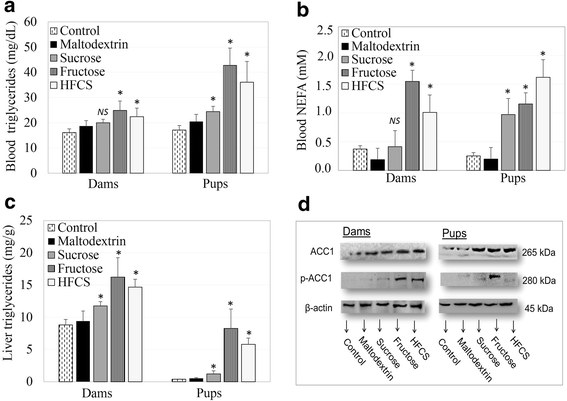Maternal dietary free or bound fructose diversely influence developmental programming of lipogenesis
- PMID: 29191195
- PMCID: PMC5709843
- DOI: 10.1186/s12944-017-0618-z
Maternal dietary free or bound fructose diversely influence developmental programming of lipogenesis
Abstract
Background: Maternal dietary choices throughout preconception, pregnancy, and lactation irreversibly affect the development of fetal tissues and organs, known as fetal programming. Recommendations tend to emphasize reducing added sugars. However, the impact of maternal dietary free or bound fructose in added sugars on developmental programming of lipogenesis is unknown.
Methods: Virgin Sprague-Dawley rats were randomly divided into five groups. Rats were given feed and plain water (control) or water containing maltodextrin (vehicle), fructose, high-fructose corn syrup (HFCS) containing 55% fructose, sucrose (20% w/v) for 12 weeks before mating and throughout the pregnancy and lactation periods. Body weight, water, and feed intake were measured throughout the study. At the end of the lactation period, blood was drawn to determine the fasting levels of glucose, insulin, triglycerides, and non-esterified fatty acids (NEFA) in blood. Triglycerides and acetyl Co-A Carboxylase-1 (ACC1) levels in livers were analyzed, and insulin resistance was calculated.
Results: The energy intake of dams in the HFCS group was higher than in the fructose group, while weight gain was less in the HFCS group than in the fructose group. HFCS resulted in greater insulin resistance in dams, whereas free fructose had a robust effect on the fetal programming of insulin resistance. Free fructose and HFCS in the maternal diet increased blood and liver triglycerides and NEFA content in pups. Furthermore, fructose and HFCS exposure increased phosphorylated ACC1 as compared to maltodextrin and control, indicating greater fatty acid synthesis in pups and dams.
Conclusion: Different types of added sugar in the maternal diet have different metabolic effects on the developmental programming of lipogenesis. Consequently, high fructose intake via processed foods may increase the risk for chronic diseases, and free fructose might contribute to developmental programming of chronic diseases more than bound fructose.
Keywords: Fetal programming; Fructose; Insulin; Non-esterified fatty acids; Triglyceride.
Conflict of interest statement
Ethics approval
All animals received ethical and humane care within the provisions of the “National Ministry of Food, Agriculture, and Livestock Regulations on the Protection and Welfare of Animals Used for Experimental and Other Scientific Purposes” and Institutional Guidelines. Experiments were approved by the Animal Ethics Committee of Hacettepe University, Ankara, Turkey (IRB Number: 2012/57–04).
Consent for publication
The authors declare no consent for publication yet.
Competing interests
The authors declare that they have no competing interests.
Publisher’s Note
Springer Nature remains neutral with regard to jurisdictional claims in published maps and institutional affiliations.
Figures




References
MeSH terms
Substances
Grants and funding
LinkOut - more resources
Full Text Sources
Other Literature Sources
Miscellaneous

